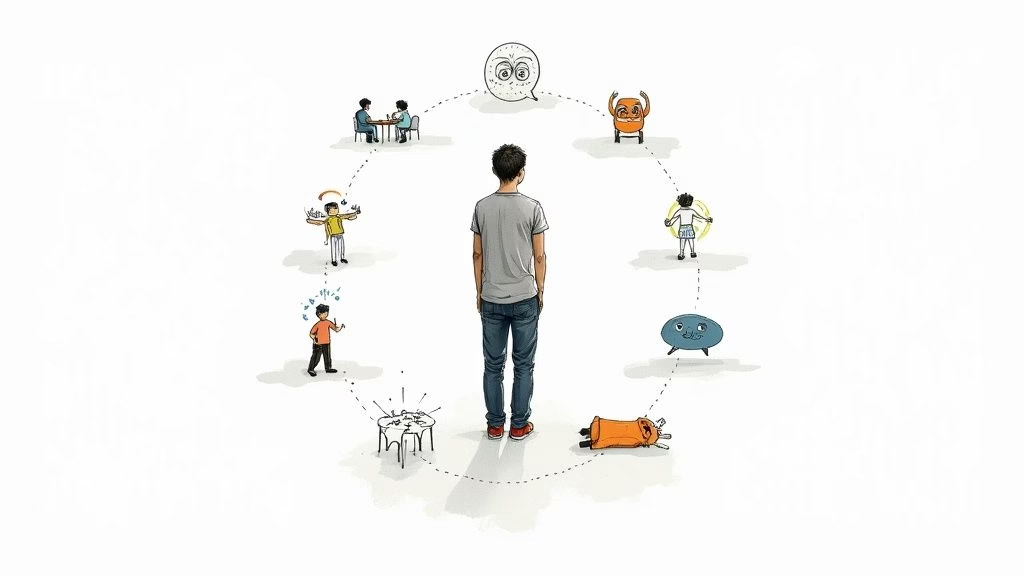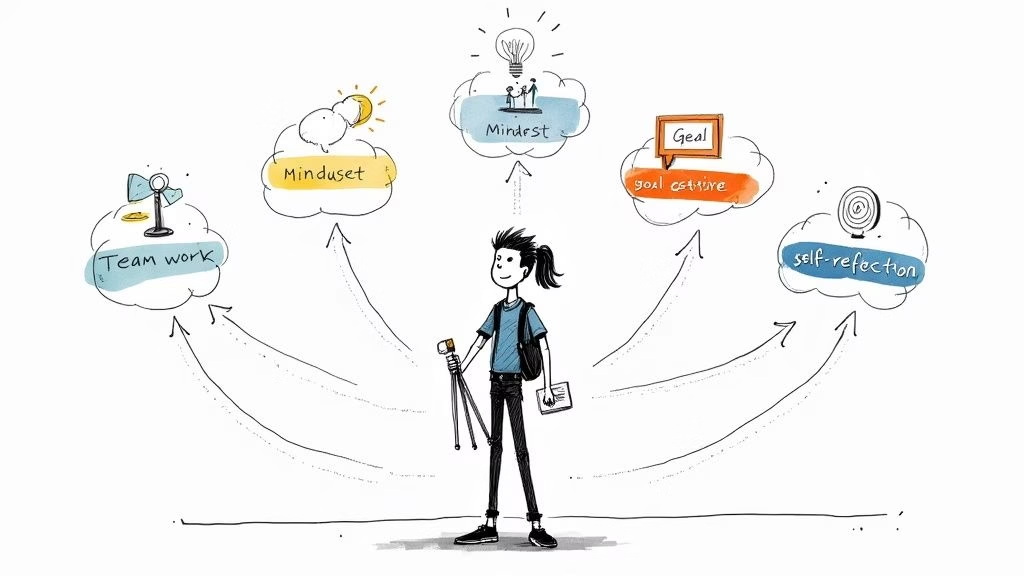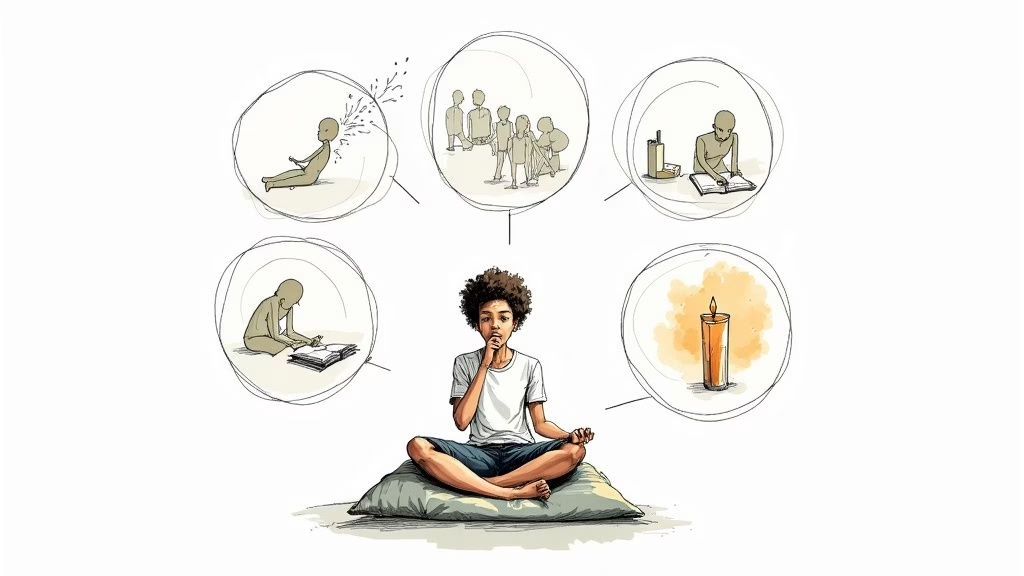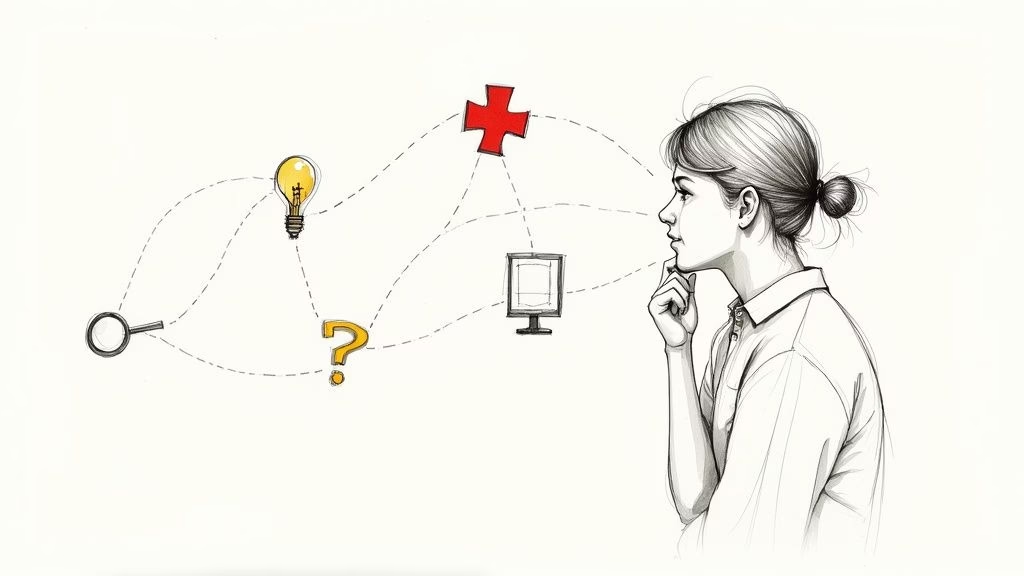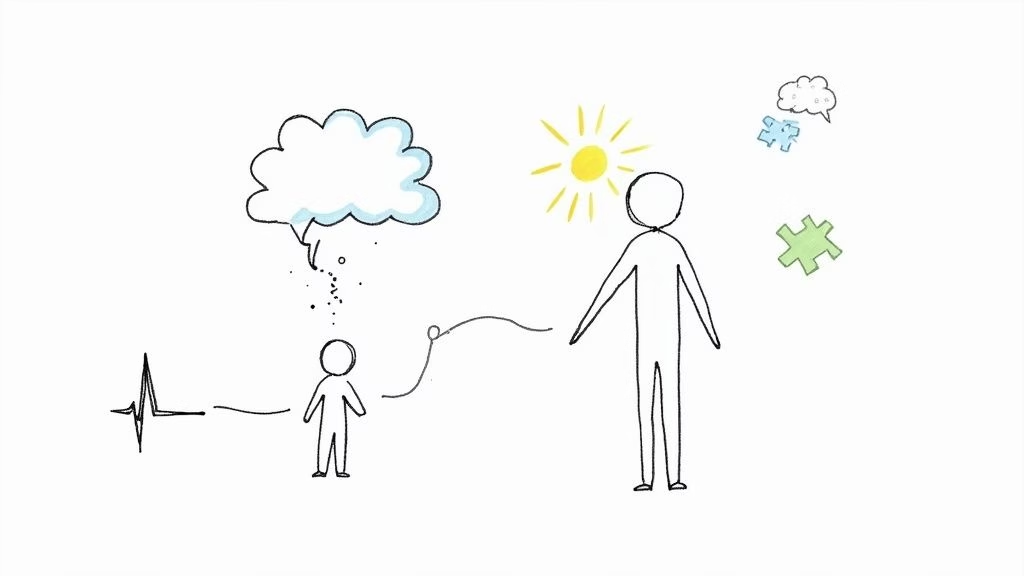It can feel like you're speaking a completely different language than your teenager. If you've ever felt that way, you're not alone. The way teens connect today has been fundamentally reshaped by technology, and understanding this shift is the first step toward bridging the communication gap.
The goal isn't just to "fix" their communication; it's to build a bridge between their digital world and the crucial face-to-face interactions that will shape their future. It's about giving them the confidence to express themselves clearly and authentically, no matter the setting.
Why Modern Teen Communication Is So Different
Today's teens have grown up in a world of fast-paced, visual, and often asynchronous platforms. Their communication habits are built around what works best in that digital space.
A 2025 deep dive into the habits of international teens revealed that Instagram, TikTok, and Snapchat dominate their social lives, with WhatsApp as their go-to for direct messaging. This digital-first environment favors quick, visual exchanges over the longer, more nuanced conversations many of us grew up with.
This isn't necessarily a bad thing, but it does mean they get far less practice reading body language, hearing tone of voice, and picking up on all the other nonverbal cues that are essential for in-person connection.
The Digital Disconnect: What's Lost in Translation
This constant digital interaction creates a unique challenge. A teen might be a master of emojis and slang-filled texts, but that same teen can struggle with the subtle art of a real-life conversation. This gap can affect everything from their confidence in the classroom to their ability to navigate friendships.
A teen might misinterpret a friend's one-word text as a sign of anger because they can't see the smile or hear the relaxed tone that would normally go with it. This is where the disconnect happens, and it's where so many misunderstandings begin.
The reality is that what works online doesn't always translate offline. There's a whole different set of skills required when you're standing in front of someone.
Digital vs. In-Person Communication Skills
Let's break down how these two worlds build different communication muscles.
| Skill Area | Digital Communication Trait (Online) | Essential In-Person Skill (Offline) |
|---|---|---|
| Pacing | Instant, rapid-fire responses | Pausing, thinking before speaking |
| Non-Verbal Cues | Relies on emojis, GIFs, and memes | Reading facial expressions, body language, tone |
| Clarity | Uses slang, abbreviations, and shorthand | Articulating thoughts clearly and completely |
| Conflict | Can easily avoid, block, or ghost | Navigating disagreements face-to-face |
| Vulnerability | Often curated or performed | Expressing genuine emotion and listening with empathy |
This table isn't about judging one as better than the other; it's about recognizing they are fundamentally different. Teens are becoming experts in one column while getting less and less practice with the other.
The following infographic highlights just how much teens themselves feel this gap.

The numbers are clear: 51% of teens want to improve their communication skills, and 42% feel misunderstood. They know there's a problem, but they often don't have the tools to fix it.
Bridging the Gap at Home: A Parenting Tip
Understanding these dynamics is the key for parents. The answer isn't to ban technology or demonize their digital lives. Instead, it's about consciously and intentionally creating opportunities for real-world connection to happen.
This is about more than just having better conversations. When teens feel misunderstood or can't express themselves, it can fuel anxiety, lead to social withdrawal, or cause them to procrastinate with schoolwork. It's all connected.
By helping your teen build these essential in-person skills, you’re not just helping them talk better—you’re giving them the tools for resilience and success in every area of their life. For parents looking for practical ways to get started, exploring structured social skills activities for teenagers can provide a great foundation for building confidence through hands-on practice.
The Power of Truly Listening to Your Teen

Before a teen will ever really open up, they have to feel heard. I mean truly heard. This goes way beyond just putting your phone down for a minute; it’s about creating an atmosphere where they feel safe enough to be vulnerable with you.
Strong communication is built on trust, and that trust begins with your ability to actively listen.
Active listening isn't just about waiting for your turn to speak or jumping in with a quick fix. It’s an art form, really. It shows respect and genuine interest. When your teen shares something tough, they're often just testing the waters—seeing if you can handle their reality without judging them or immediately trying to correct it.
Putting Active Listening Into Practice: A Parenting Tip
One of the most powerful things you can do is simply validate their feelings. This is huge. You don’t have to agree with their choices to acknowledge their emotions.
Let’s say your teen is bummed out about a bad grade. Your gut instinct might be to launch into a lecture about study habits. But hold that thought.
Try starting with validation instead.
"It sounds like you're really disappointed about that test score. I can see why you feel so frustrated, especially after you put in the study time."
This one statement does two critical things: it names the emotion (disappointment, frustration) and shows you’re on their side. That small shift can completely defuse the tension and open the door to a real conversation about what to do next. It stops things from escalating into a fight before they even begin.
Another key is to ask open-ended questions. These are the questions that can’t be shut down with a simple "yes" or "no."
- Instead of asking: "Did you have a fight with your friend?"
- Try something like: "What happened with you and Sarah today?"
See the difference? The second one invites a story, not just a one-word answer. It signals that you’re actually interested in their perspective and ready to listen.
Building Trust Through Understanding
Paraphrasing is another great tool in your belt. It’s a simple way to show you’re locked in and paying attention. After your teen has finished sharing, just repeat back what you heard, but in your own words.
For example: "So, if I'm getting this right, you're feeling totally overwhelmed because your coach wants more practice time, but you're already swamped with that big history project."
This does two things: it confirms you understood them, and it gives them a chance to clarify if you missed something. It’s a powerful way to show you’re trying to see the world from their point of view. When teens feel seen and understood, their willingness to engage skyrockets.
Honestly, effective listening is a cornerstone of mental wellness. When teens know they have a safe place to process their worries—whether it’s about friends, school, or the future—it acts as a powerful buffer against anxiety. Experts at organizations like the National Communication Association have shown that these skills are directly linked to higher self-esteem and even better grades.
By mastering the art of listening, you’re not just having better conversations; you're giving your teen an incredible tool for building resilience for life.
Discussing School, Motivation, and Procrastination Without a Fight

We've all been there. The minute you bring up grades or homework, the walls go up. Suddenly, a simple conversation turns into a lecture, then a nagging session, and finally, a full-blown argument. It’s a draining cycle.
If this sounds familiar, it’s time to change your approach. The secret to breaking this pattern is shifting your role from enforcer to partner.
When a teen starts procrastinating or their grades begin to slide, it’s almost never about being lazy. The real issue is usually something deeper—maybe they’re anxious about failing, completely swamped by the workload, or just can’t find a reason to care about the material. Lecturing just piles on more pressure.
Instead, try opening the door with an observation, not an accusation.
“I’ve noticed you seem stressed about your history class lately. I’m here to listen if you want to talk about what’s going on.”
An approach like this shows you see them, not just their report card. It validates their feelings and signals that you’re a safe person to talk to, turning a potential showdown into a moment of connection.
From Conflict to Collaboration: A Parenting Tip
Once you've opened that door, the goal is to work together. This is where you have to resist the powerful urge to jump in with your perfectly crafted fix-it plan. Don't do it.
Instead, ask questions that get them to think for themselves.
- To tackle feeling overwhelmed: "What part of this project feels the most difficult to even start?"
- To understand procrastination: "When you think about starting your homework, what’s the main feeling that comes up for you?"
- To brainstorm together: "What’s one small thing we could do right now to make this feel more manageable?"
These kinds of questions immediately position you as a teammate. You’re not there to solve the problem for them; you're there to help them build the skills to solve it themselves. That's how real confidence and independence are built.
Tying Motivation to Their Mental Health
It’s so important to remember the link between a teen's motivation, procrastination, and their overall mental well-being. A sudden drop in effort or a constant "I don't care" attitude can be a red flag for anxiety or depression. When a teen feels good, they’re far more likely to be engaged and motivated.
If you suspect something deeper is going on, getting professional support can be a game-changer. These organizations are fantastic resources for both parents and teens:
- The Child Mind Institute: A goldmine of expert articles and guides on everything from ADHD to teen anxiety and procrastination.
- The Jed Foundation (JED): Focuses on protecting emotional health and preventing suicide for teens and young adults.
- Psychology Today: Has a therapist directory that can help you find qualified professionals near you who specialize in adolescent mental health.
When you approach these tough conversations with empathy and a focus on teamwork, the entire dynamic changes. You build trust, teach invaluable life skills, and get to know your teen on a deeper level. For more strategies, check out our guide on how to motivate a teenager without all the fighting.
Encouraging Real-Life Connection in a Digital World

Let's be honest: much of a teen's social life now happens through a screen. Because of that, carving out time for actual, face-to-face connection has become a conscious decision we have to make as parents. This isn't about starting a war on technology. It’s about intentionally creating an environment where genuine, offline moments can actually happen.
It’s about more than just limiting screen time—it’s about nurturing the teen communication skills they need to build real-world confidence. When teens get regular chances to interact without a phone in their hand, they practice reading body language, hearing the subtle shifts in someone's tone, and navigating the natural back-and-forth of a conversation. Those are skills you just can't master over text.
Creating Tech-Free Opportunities: A Parenting Tip
The way teens hang out has completely changed. Research shows that between 2003 and 2022, face-to-face time among U.S. teenagers dropped by a staggering 45%. Schools have definitely noticed. By the 2019-20 school year, 76.9% had already banned non-academic mobile phone use.
After a 2023 Florida law prohibited cellphone use during class, teachers reported a clear spike in student engagement. Even better, teens said they felt happier and less stressed. You can read more on these findings and their impact from Effective School Solutions.
You can bring these same principles home by setting up tech-free zones or times. This isn't a punishment; it's a family agreement to be more present with each other.
- The Dinner Table Rule: Make the dinner table a phone-free zone for everyone, parents included. No exceptions.
- The "Digital Sunset": Pick a time each evening when all devices get put away to charge for the night, preferably outside the bedroom to protect their sleep.
- The Weekend Activity: Plan one activity every weekend that's naturally screen-free. Think a hike, a bike ride, or even just baking something together.
The key here is to make it a collaboration. Frame it as something that benefits the whole family’s well-being, not just a bunch of rules for them. Try asking, "How can we make sure we have some time to just connect without our phones buzzing?" Giving them a voice in the process makes them far more likely to get on board.
From Procrastination to Presence
Interestingly, this push for real-world connection can also help with things like school motivation and procrastination. When teens are constantly pulled away by notifications and the social pressure to be online 24/7, their ability to focus on something demanding—like homework—takes a serious hit.
Cutting down on those digital interruptions helps them concentrate and reduces that feeling of being overwhelmed that so often leads to putting things off. By building an environment with fewer distractions, you’re not just boosting their teen communication skills; you’re also supporting their academic focus and mental health.
A teen who feels connected and present is simply better equipped to handle the challenges school and life throw at them.
Communication and Teen Mental Health: The Inseparable Link
How teens communicate—or don't—is deeply tied to their mental wellness. It’s more than just avoiding arguments over chores. Strong, open communication at home is one of the most powerful protective buffers against the intense pressures teens face every day.
When a teenager feels they have a safe space to express themselves, they learn to process complex emotions like anxiety, frustration, and disappointment in healthy ways. Without that outlet, those feelings get bottled up, which can often lead to more significant mental health challenges down the road. That's why building strong teen communication skills is a core part of developing real emotional resilience.
Recognizing When Digital Life Affects Well-being
It’s impossible to ignore how modern digital life fits into this picture. While social media can give teens a sense of community, it can just as easily become a major source of stress.
The World Health Organization has been tracking this, and their research is eye-opening. Problematic social media use among adolescents shot up from 7% to 11% between 2018 and 2022 in Europe, Central Asia, and Canada. This kind of behavior—marked by a lack of control and negative consequences—is directly linked to mental health issues, as more screen time often weakens a teen's ability to read real-world social cues. You can read more in the WHO's 2024 report.
Constant exposure to curated online personas can fuel social comparison and anxiety. When a teen’s primary mode of interaction is digital, they may struggle more with in-person communication, leading to feelings of isolation even when they seem constantly connected.
This is why paying attention to your teen's behavior is so important. A noticeable shift in how they communicate can be a subtle but clear sign that something is off.
How to Start a Conversation About Mental Health: A Parenting Tip
If you're worried, how you bring it up makes all the difference. Ditch the direct accusations like, "You're always on your phone." That just puts them on the defensive. Instead, lead with empathy and a simple observation.
Try starting with a gentle opening:
- "I've noticed you seem a bit down lately. Just wanted you to know I'm here if you want to talk about anything."
- "You seem to have a lot on your mind. Is everything okay?"
- "It feels like we haven't really connected much recently. I miss talking with you."
The goal is to open a door, not force your way through it. The way you handle these delicate conversations reinforces that you are a safe person to turn to when life gets tough. This is especially true for young men, who often face unique pressures to hide their struggles. Getting a better handle on the specific challenges they face is crucial, and exploring resources on teen boys' mental health and mentorship can give parents the perspective and tools they need.
Trusted Mental Health Resources for Parents and Teens
You don't have to navigate this journey alone. If you suspect your teen is dealing with more than just typical moodiness, professional help is out there.
Here are a few excellent places to start:
- The Jed Foundation (JED): Offers a wealth of resources and support specifically focused on protecting emotional health and preventing suicide for teens and young adults.
- Child Mind Institute: Provides expert articles, practical guides, and solid advice on a wide range of teen mental health topics.
- National Alliance on Mental Illness (NAMI): Offers family support groups and extensive information on various mental health conditions affecting teens.
Remember, building strong communication is one of the most important things you can do to support your teen's well-being. It creates a foundation of trust that will help them navigate the inevitable challenges of school, friendships, and just growing up.
Common Questions About Talking with Teens
Even with the best intentions, some communication hurdles with teenagers just keep coming up. I get these questions from parents all the time. Let’s break down some of the most common sticking points and give you a few practical tools for your parenting toolkit.
How Can I Get My Teen to Talk More?
If you're stuck in a loop of one-word answers, it’s probably time to change up your approach. The secret is often about shifting the context of the conversation and the kind of questions you ask.
Think about it: direct, face-to-face questions the second your teen walks in the door can feel more like an interrogation than a conversation. Instead, try talking while you're doing something side-by-side. Driving, walking the dog, or even just cooking dinner together can lower the pressure and make talking feel more natural. It's less intense.
You also need to upgrade your questions. "How was your day?" is a notorious conversation-killer.
- Instead, try: "What was the most interesting part of your day?"
- Or you could ask: "Tell me about something funny that happened in class."
These open-ended questions invite a story, not just a simple "fine." It also helps to model this yourself. Share a quick, interesting detail about your own day without demanding they share back immediately. It shows them what an open, give-and-take conversation actually looks like.
What Is the Best Way to Set Phone Rules?
The goal here should be collaboration, not dictatorship. When you frame the conversation around shared values—like health, sleep, and genuine family connection—it becomes a team effort instead of a power struggle.
Start with something like, “I want to talk about how we can all have a healthier relationship with our phones, myself included.” This immediately signals that it’s not just about them; it's about the whole family.
Listen to their perspective first. Then, work together to create a "Family Tech Agreement" with clear, simple rules you can all live with.
For example, you might all agree on "no phones at the dinner table" and a "digital sunset" time, where all devices are put away for the night. When teens help create the rules, they have a real stake in them and are far more likely to follow them without a fight.
When Should I Worry About a Lack of Communication?
It's normal for teens to be moody or want more privacy. That’s just part of growing up. But it’s also important to watch for sustained changes that might signal something more serious is going on. Pay attention to shifts that last for several weeks, not just a few bad days.
A few key red flags that could point to a mental health concern include:
- Complete withdrawal from friends and activities they used to love.
- A significant and sudden drop in school performance or motivation.
- Drastic changes in their sleep patterns or appetite.
- Frequent expressions of hopelessness, worthlessness, or despair.
If you notice a cluster of these signs, it's time to act. Gently express your concern, maybe starting with something like, "I've noticed…" and consider reaching out to a school counselor, pediatrician, or a mental health professional for guidance. Strong teen communication skills are vital, but knowing when to bring in outside support is just as crucial for their well-being.
At Andrew Petrillo Life Coaching, we understand that communication is just one piece of the puzzle. If your teen is struggling with motivation, procrastination, or navigating the pressures of school and life, we can help. Andrew provides one-on-one coaching to build the practical skills and confidence teens need to succeed. Schedule a complimentary discovery call today at https://andrewpetrillolifecoaching.com to learn more.





